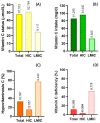Global Vitamin C Status and Prevalence of Deficiency: A Cause for Concern?
- PMID: 32640674
- PMCID: PMC7400810
- DOI: 10.3390/nu12072008
Global Vitamin C Status and Prevalence of Deficiency: A Cause for Concern?
Abstract
Vitamin C is an essential nutrient that must be obtained through the diet in adequate amounts to prevent hypovitaminosis C, deficiency and its consequences-including the potentially fatal deficiency disease scurvy. Global vitamin C status and prevalence of deficiency has not previously been reported, despite vitamin C's pleiotropic roles in both non-communicable and communicable disease. This review highlights the global literature on vitamin C status and the prevalence of hypovitaminosis C and deficiency. Related dietary intake is reported if assessed in the studies. Overall, the review illustrates the shortage of high quality epidemiological studies of vitamin C status in many countries, particularly low- and middle-income countries. The available evidence indicates that vitamin C hypovitaminosis and deficiency is common in low- and middle-income countries and not uncommon in high income settings. Further epidemiological studies are required to confirm these findings, to fully assess the extent of global vitamin C insufficiency, and to understand associations with a range of disease processes. Our findings suggest a need for interventions to prevent deficiency in a range of at risk groups and regions of the world.
Keywords: LMIC; communicable disease; dietary intake; hypovitaminosis C; infection; low and middle income; non-communicable disease; supplement; vitamin C deficiency; vitamin C status.
Conflict of interest statement
The authors declare no conflicts of interest.
Figures


References
Publication types
MeSH terms
Substances
LinkOut - more resources
Full Text Sources
Medical

